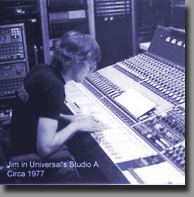
 .
.
Jim
Scheffler started his audio career at Universal Recording in 1975.
Jim's musical training was soon appreciated for one of his first
assignments, editing the session takes for The Chicago Chamber
Orchestra. With only the conductor’s scores and notes, Jim
created the finished Masters. Jim's
appreciation of music was learned from the earliest age.
"My mother was trained in classical
Jim
started piano at age 7 then decided to take guitar lessons at age 9.
"I had a gut 6 string to start with but I also was listening
to the Beatles by then so of course, I wanted an electric guitar.
Dad wanted me to work and save for my hobby projects, so I would
work for him around the family florist business green houses to save up
for my electric guitar.
I learned the value of hard work and setting goals.
I really appreciate that now."
Jim's first guitar amp was a Heathkit that he built himself when
he was 10. "That
amp was not a very good sounding amp but it still works!" Jim
reports. "I guess that speaks of my soldering work as a kid, it
isn't pretty but no cold solder joints!"
Jim
also discovered an interest in theatre production when he was a kid,
first lighting and then recording shows and sound design.
"My family got involved in a community theatre group so it
started when I was quite young.
I guess the lights caught my eye! (Wink)
I built a puppet stage with lights and dimmers and my brother and
I would record a sound track with music and sound effects and all the
voices and share in the puppeteer chores.
He's a couple years younger and we were just kids."
"One
of my fondest memories of those early days was when my mother played
Jim
also loved listening to Big Band and jazz band so when he heard Drum and
Bugle Corps for the first time at age 13 he immediately wanted to record
it. Not only did Jim record
some Drum Corps contests, he also picked up a bugle and joined a Corps
mid season. Jim learned all
the marching steps and started marching in competition after just 3
days! “I had never played
a brass instrument at all so I had to learn to “blow” and not suck,
so that first competition I was just faking like I was playing.
I was filling a hole in the line so I just needed to remember
where I needed to be, that was challenge enough!”
But of course that was only a start, he had to learn to play and
memorize the whole thirteen minute “book”, and he had only 10 days
to do it. Jim went on to
play for two seasons until the dream job was handed to him.
“I
wanted to record music more than anything,” explains Jim, “I
consumed every book the library had to offer on the subject or related
topics”. So when Jim had
an opportunity to attend the Recording Institute of America at a
It took
only a year of on the job training and Jim had a signed contract for
three years and a full membership in local #476 of I.A.T.S.E. the union
of mixers and technicians.
After five years in
Over
the years, Jim has had the privilege of working with, and learning from
a few of the world’s greatest recording engineers.
Murray Allen, Doug Brand, Toby Foster, Al Schmitt, Bill Schnee,
and Bruce Swedien to name a few.
Jim
has also designed sound systems for churches and theaters, and for
touring companies using many venue types including convention centers,
arenas and stadiums. He
enjoys live mixing as much as working in the studio.
L.A. area Studios that Jim has recorded and/or mixed in include; A&M Records (now Henson Studios), Ameraycan Studios, American Recording, Amigo, Annex, Baby O, Backroom Recorders, Bell Sound, Can-Am Recording, Capitol Recording Studios, Cherokee Recording Studios, The Complex, Conway Recording, Devonshire, Dennis Dragon Studio, Encore Studios, Inc., The Enterprise, Entourage Studios, Evergreen Recording Studios, Group IV, Hollywood Sound Recorders, House of Blues Studios, Lighthouse Recorders, Lion Share Recording Studio, Mad Dog, Mad Hatter Studio, Magnolia Sound, Mama Jo’s Studio, Martinsound, MCA/Whitney, MGM Scoring Stage (Now Sony Scoring), Monterey Recording Studio, Motown/Hitsville, Music Grinder, Ocean Way, Pacifique Recording, Paramount Recording, Peace in the Valley, Producer’s Recording, Record One, Record Plant, Rumbo Recorders, Rusk Sound Studios, Sage & Sound Recording, Skip Saylor Recording, Bill Schnee Studio, Score One Recording, Inc., Skyline Recording, Sound Castle, Sounder Recording, Stagg Street Studio, Studio 55, Studio Ultimo, Sunset Sound, Sunset Sound Factory, Sun West Recording, Take One Recording Studio, Todd A-O Scoring (Formerly Radford Street Scoring Stage), George Tobin Studios, Track Record, United Western, Village Recorders, Weddington Studios, Western United, Westlake Studios, Whitefield Studios.
home
artist credits feature films
albums &
soundtracks television
sample
recordings contact jim
.